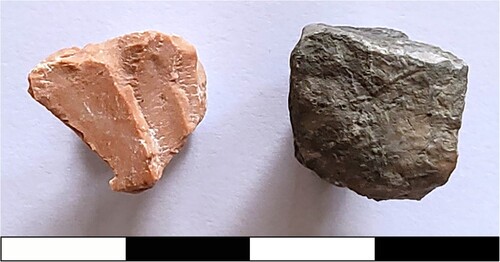Figures & data
Figure 1. Map of Etruria showing the location of Vetulonia (the shoreline reflects the geo-morphological situation during the early 1st millennium BCE). Bottom image: grey = hypothetical settled area; white = early Iron Age cemeteries (Colle Baroncio encircled by the dashed line).
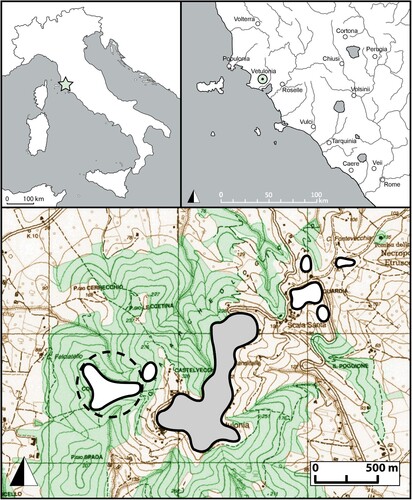
Figure 2. (A) Distribution of the Villanovan culture in the Italian peninsula (black areas). (B) Section of a typical early Iron Age grave of Vetulonia, based on the descriptions by Helbig (Citation1885), Falchi and Pasqui (Citation1885) and Falchi (Citation1891). At Colle Baroncio, the burials were commonly marked by a vertical slab. (C) Photographs of pottery from the cemetery of Colle Baroncio. From top to bottom, the finds from which samples VT-CB 2, VT-CB 27, VT-CB 40 and VT-CB 3 were taken. (D) Examples of biconical urns and cover-bowls typical of Vetulonia. Clockwise from top left, the vessels used to take samples VT-CB 30, VT-CB 39, VT-CB 14 and VT-CB 18.
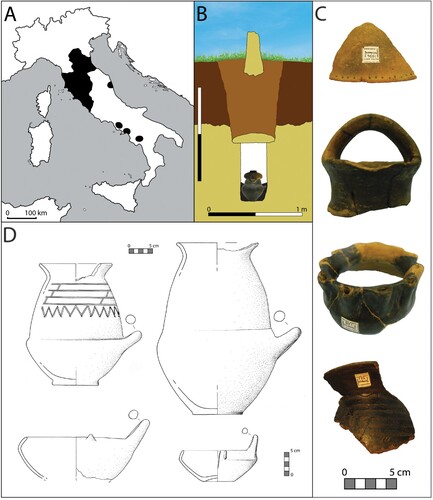
Figure 3. Geological map showing the main units in the territory around Vetulonia (numbers) and the location of the geological samples analysed in this study (letters). Formation 1: sands, pebbles and muds (alluvial, aeolian, lacustrine, palustrine, lagoonal, shore deposits) (Quaternary). Formation 3: conglomerates, sandstones, siltstones, clays and limestones of fluvio-lacustrine environment (Ruscinian-Villafranchian). Formation 27: shales, limestones and siltstones (Paleocene-Eocene). Formation 31: internal sandstone flysch: sandstones, siltstones with olistostromes (Chattian-Aquitanian). The colours used for all units refer to the official geological map of Tuscany (Carmignani et al. Citation2004). The dotted grey area marks the wetland of Diaccia Botrona, and the asterisk marks the formation with flint nodules south of Punta Ala. For the letters marking the geological samples collected for analysis, see .
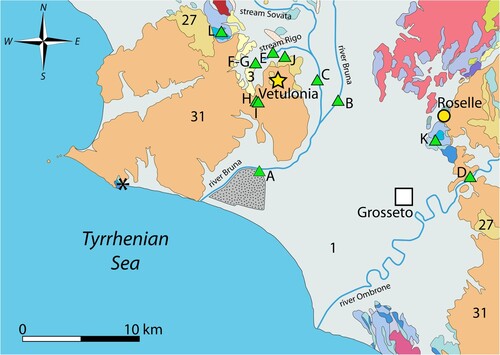
Table 1. Association between vessel morphology and ceramic fabric of the sampled sherds.
Figure 4. Location of the geological samples taken to produce comparative thin sections. A: Brackish wetland of Diaccia Botrona; B: River Bruna; C: River Sovata; D: River Ombrone; E: Tributary of stream Rigo; F: Sandstone from Formation 3; G: Clay from Formation 3; H: Sandstone from Formation 31; I: Clay from Formation 31; J: Claystone from Formation 27; K: Hill of Poggio Moscona containing flint nodules (Formation 33); L: Flint nodules from Poggio Paganella (Formation 33).
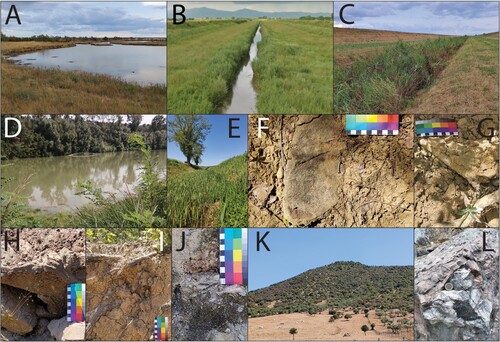
Figure 5. Colour, evidence for forming techniques and surface treatment of Villanovan vessels from Colle Baroncio. A: blackish/dark grey surface of pottery fired under reducing conditions; B: Coiling traces on a biconical urn; C: Parallel marks left by surface treatment on the handle of a biconical urn.

Table 2. Characteristics of ceramic fabrics.
Figure 6. Thin-section photomicrographs of selected archaeological ceramic samples from the Villanovan cemetery of Colle Baroncio. Fabric A (non-tempered clay): 1. VT-CB 4; 2. VT-CB 5; 3. VT-CB 10; 4. VT-CB 14; 5. VT-CB 15; 6. VT-CB 31. Fabric B (clay tempered with flint): 7. VT-CB 8; C: 8. VT-CB 36; 9. VT-CB 37. Fabric C (clay tempered with metasedimentary rocks): 10. VT-CB 2; 11. VT-CB 2; 12. VT-CB 2. All pictures taken under XP; field of view: nos. 1–3, 5–6, 8–9, 11–12 = 1.5 mm; nos. 4 = 3 mm; nos. 7, 10 = 6 mm.
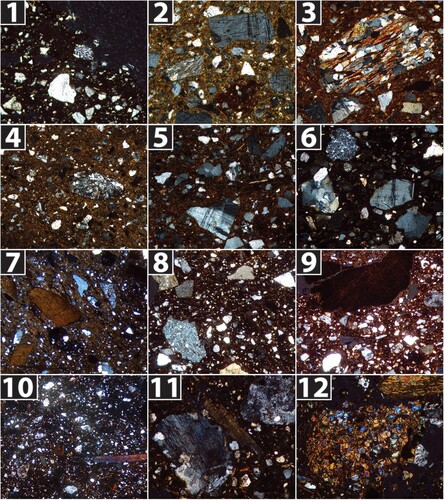
Figure 7. Thin-section photomicrographs of geological samples from the territory of Vetulonia. 1. Fine sediment fraction from River Ombrone; 2. Fine sediment fraction from River Ombrone; 3. Fine sediment fraction from River Bruna; 4. Fine sediment fraction from Stream Sovata; 5. Fine sediment fraction from Stream Sovata; 6. Fine sediment fraction from a tributary of stream Rigo; 7. Fine sediment fraction from the brackish wetland of Diaccia Botrona; 8. Clay from Formation 3; 9. Sedimentary rock from Formation 3; 10. Clay from Formation 31; 11. Sedimentary rock from Formation 31; 12. Flint from Formation 33 near Caldana. All pictures taken under XP; field of view: nos. 1–5, 7, 12 = 1.5 mm; nos. 6, 8–11 = 3 mm.
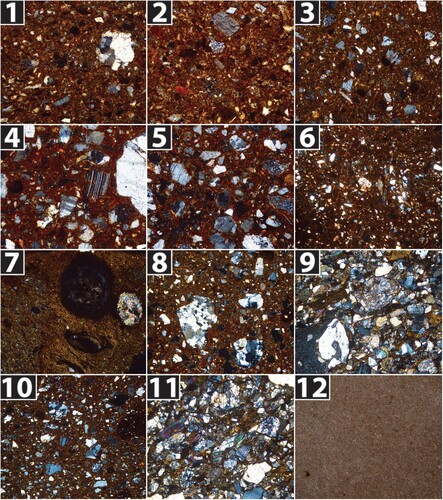
Figure 8. Unfired flint (left) and flint subjected to firing in a reducing atmosphere (right). Scale bar = 4 cm.
